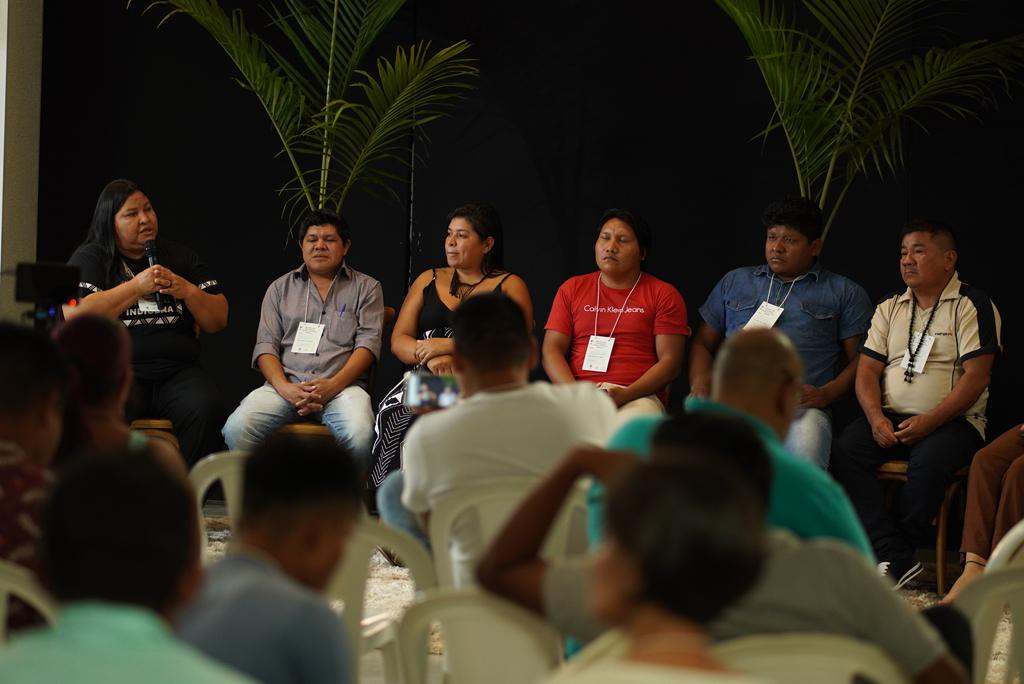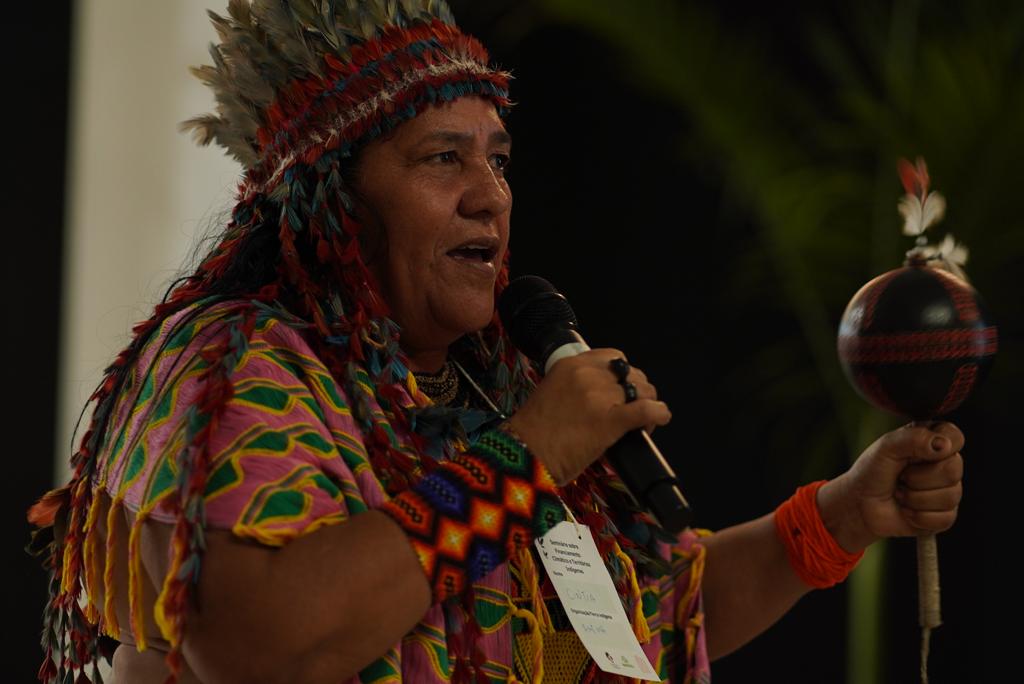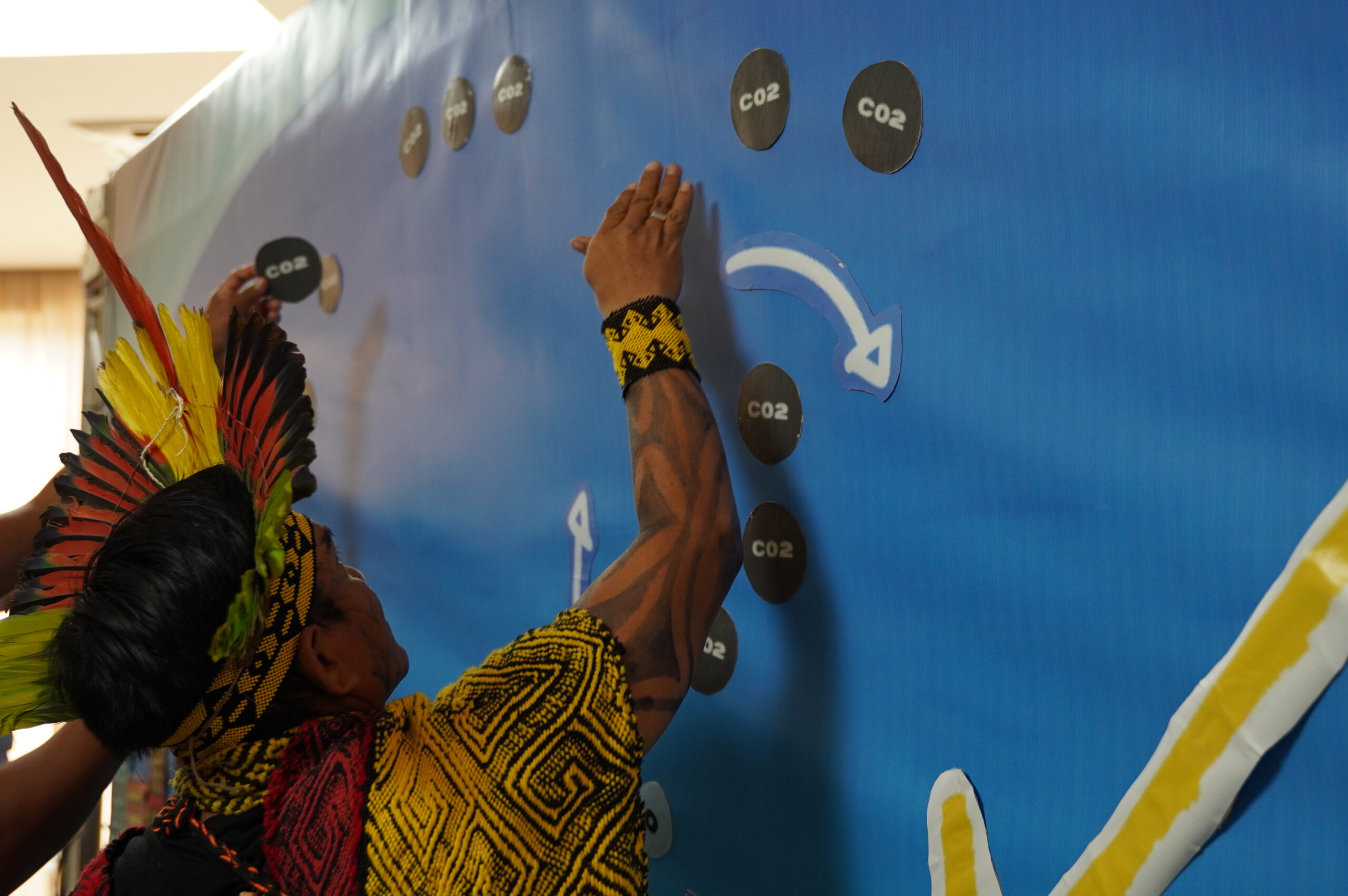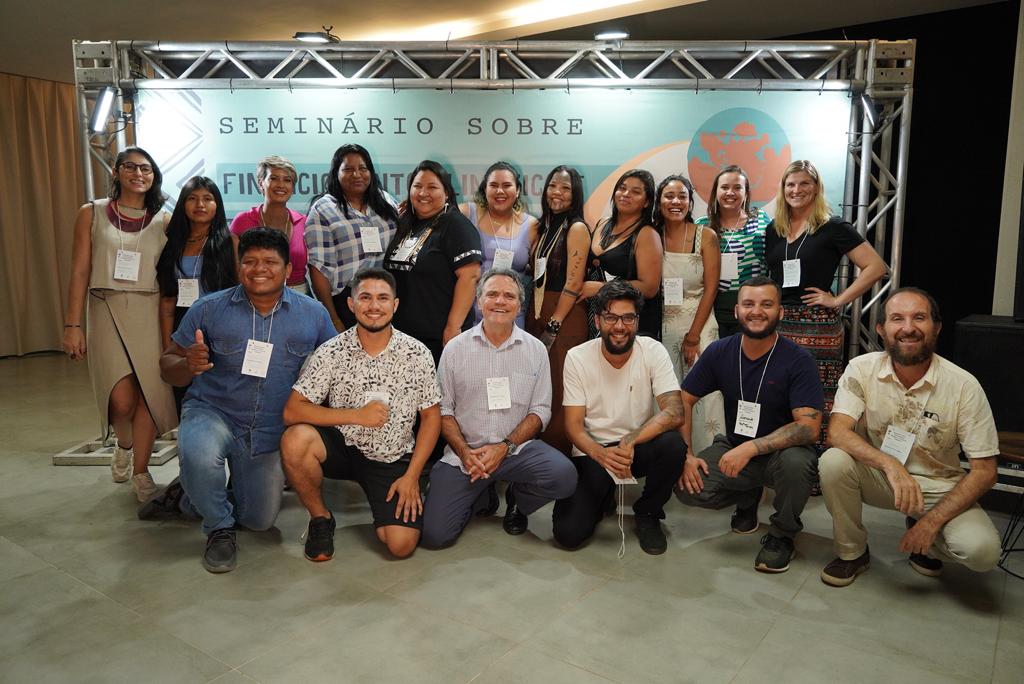For indigenous and local communities, climate finance is often an unwelcoming space. Climate finance programs are technical, with complicated methodologies and legal agreements. Most do not disperse funds directly to indigenous peoples and local communities (IPLCs), leaving millions stuck in bureaucratic distribution systems. A minimal percentage of aid money for climate mitigation reaches IPLCs , despite initiatives that pledge billions to the cause – some estimate as little as under 1% goes directly to communities.

With momentum and interest in biodiversity and carbon offsets gaining after the UN Biodiversity Conference in December 2022, and the Lula administration in Brazil signaling intention to act on conservation and human rights, it is essential that IPLCs have the resources they need to navigate new opportunities and rapidly changing contexts.
On February 14th and 15th in Cacoal, Rondônia, Brazil, our Communities and Territorial Governance Initiative held a seminar on climate finance and Indigenous Territories, in partnership with Greendata. The goal of the Cacoal gathering was to exchange ideas and increase community knowledge on REDD+ and other jurisdictional and private climate finance mechanisms, including voluntary carbon markets. Our team presented updated information on climate finance, discussed opportunities for community engagement that prioritize safeguards and indigenous rights, and conducted trainings with indigenous and non-indigenous experts.

Over 100 participants joined from across Brazil, including representatives of 25 original peoples of the Brazilian Amazon; members of indigenous organizations, such as the Coordination of Indigenous Organizations of the Brazilian Amazon (COIAB), the Federation of Indigenous Peoples and Organizations of Mato Grosso (FEPOIMT), the National Articulation of Indigenous Women Warriors of Ancestrality (ANMIGA), the Association of Indigenous Warrior Women of Rondônia (AGIR), and the Indigenous Youth of Rondônia (JIR); legal experts; and representatives from regional and national agencies, including the Coordinating Body for Indigenous Peoples of Rondônia (COPIN), the State Secretariat for Environmental Development of the State of Rondônia (SEDAM), the Federal Public Ministry (MPF), Wildlife Works (WWC), the Pro-Indian Commission of Acre (CPI-AC), and the Platform Partners for the Amazon (PPA).
“In order for indigenous organizations and communities to evaluate climate finance opportunities, assess their territories’ carbon stocks and flows, negotiate with governments and private carbon market actors, understand their legal rights and the regulatory environment, and so forth, they need to have quality, tailored information and the appropriate tools and capacities,” says Beto Borges, Director of Forest Trends’ Communities and Territorial Governance Initiative.
“Forest Trends is here to support this information sharing, and this seminar is an important part of that training.”
Four key lessons from this event for the global climate finance community:
1. Climate finance will flow into communities at the speed of trust, and trust requires information.
“At present, many companies do a poor job of conveying their intentions with communities, and they make promises that can’t be fulfilled,” says Nedina Luisa Yawanawa, an indigenous teacher from the Rio Gregório Indigenous Land in Acre, Brazil.
Nedina believes it is essential to have more training initiatives made available to communities that emphasize the protection of community rights and resources. Community members having a deep understanding of the consultation process and the relationship between companies and communities is essential to setting expectations and creating an equitable partnership from day one.
“It’s no use just saying that [communities] need to be careful,” says Nedina. “We can’t go on accepting the first company [that makes a proposal]. We have the [land and resources], so we have to be comfortable making the best choice…We need to operate in a way that all communities receiving proposals are aware of the risks, and if they are going to move forward, they do so consciously and with preparedness on community management, accompaniment of important institutions, like FUNAI and the MPF, and legal support so that the communities are not alone.”
“Information on jurisdictional REDD+ and carbon markets is often presented in very technical or legal language, and not necessarily in indigenous peoples’ first language,” said Marcio Halla, Director of the Territorial Governance Facility and Economic Initiatives Lead at Forest Trends. “More concerningly, we have sometimes seen information on risks de-emphasized in proposals to communities or hidden in the fine print.”
To better equip communities with the knowledge needed to evaluate and negotiate carbon finance opportunities, Forest Trends just launched a new project, with support from the Climate and Land Use Alliance, that will offer carbon finance training programs, data, and technical assistance to indigenous communities in Brazil and Panama. We hope to expand this work to additional geographies in the near future.
2. Communities can speak for themselves in global fora.

Marciely Ayap Tupari, secretary coordinator of Coordination of Indigenous Organizations of the Brazilian Amazon (COIAB) and active member of several movements in the state of Rondônia, said that the best way for the international community to support the struggle of indigenous peoples in defense of their territories is to bring them into the discussion.
“Many times, when we participate in these international meetings, we see little participation of indigenous leaders who are working with the territories. We need to participate in these spaces. Not only the leaders, but women and youth [as well] … We need to be there to talk about what our demands really are.”
Upfront investment is needed to strengthen IPLC governance so they can continue to protect their territories and participate as equal partners in climate and conservation finance. Vehicles like the Territorial Governance Facility [link in Spanish] can provide financial and technical support for governance capacity-building.
3. The relationship between communities and jurisdictional and national governments is being rebuilt.
A new administration in Brazil offers opportunities to begin building trust between indigenous communities and government agencies, after a long history characterized by neglect, colonialism, and outright aggression.
Looking forward, regional, and national governments can play a critical role helping to protect indigenous rights and promoting equitable benefit sharing of any value generated by projects. Leonardo Trevizani Caberlon, prosecutor for the Federal Public Ministry (MPF) of Rondônia, explains, “One of the roles of the Federal Public Prosecutor’s Office is defending indigenous peoples and enforcing the laws [already in place to protect their rights]. The MPF also monitors any projects that involve indigenous populations, and if the indigenous people have an interest in consultation, a [second] opinion, or monitoring, the MPF is at their disposal. The MPF will also have the important role of supervising and investigating any irregularities that may occur during the course of these procedures and could request conviction of those who may be [in violation].”
“We are encouraged that at the Federal level, Marina Silva is back as Minister of Environment and Climate Change, and the new Ministry of Indigenous Peoples is led by Sonia Guajajara, the first indigenous person to head a Ministry in Brazil. It is also the first time in Brazilian history that FUNAI is presided by an indigenous person: Joênia Wapichana, another prominent indigenous leader, who is completing her term as the first indigenous woman deputy in the Brazilian Federal Congress,” added Beto Borges.
4. Public and private finance need to align with indigenous cultures, not the other way around.
Marciely Ayap Tupari explains why the seminar’s conversations are so important for shaping how companies should interact with indigenous partners: “The whole world sees that indigenous peoples protect the forest without [asking for] money. We do it in our own way because nature is our life. Seeing this, companies often end up coming to us with a proposal, wanting to finance, wanting to supposedly protect nature, but in their own way. When we explain our vision as indigenous peoples, many do not understand. That is why we talked about this issue of companies enticing leaders, offering money to implement carbon credits, but without really talking to the people who live there. This is worrying.”
Beto Borges also emphasizes the need for culturally appropriate jurisdictional finance, adding that state governments should also adapt how they interact with indigenous communities: “While these are promising developments at the Federal level to uphold the rights of indigenous peoples, including their carbon ownership rights, we hope to see the same level of recognition and commitment by the state governments in the Amazon. Most of the state governments in the Brazilian Amazon submitted proposals to the LEAF program; it is very important, however, that they consult with indigenous peoples and involve them in the design and implementation of safeguards and fair benefit sharing mechanisms in jurisdictional climate funding. Otherwise, jurisdictional funding will fail indigenous peoples.”
A set of core principles for working with forest communities on carbon offsets and conservation projects was recently published by the Peoples Forest Partnership, a coalition of indigenous organizations, companies, investors, and nonprofits (Forest Trends is the current Secretariat). We believe these offer a useful model for the entire climate finance field to follow in partnering with indigenous and traditional communities.
Our priorities in 2023

Our team has come out of the Cacoal gathering even more energized to keep supporting our IPLC partners with these priorities. This year, we are ramping up our existing resources geared towards providing accessible, culturally appropriate information and capacity building on climate finance programs. In late 2021, we launched the Territorial Governance Facility with four IPLC organizations to strengthen the governance capacity necessary for successful participation in climate finance. February marked the beginning of a new initiative with the Climate and Land Use Alliance to co-create technical tools and other training resources with IPLCs to navigate carbon markets. We look forward to continuing our work with indigenous partners in Brazil and around the world to prioritize the resources, information, and direct support they are calling for.
Viewpoints showcases expert analysis and commentary from the Forest Trends team.
Connect with us on Facebook and Twitter to follow our latest work.
